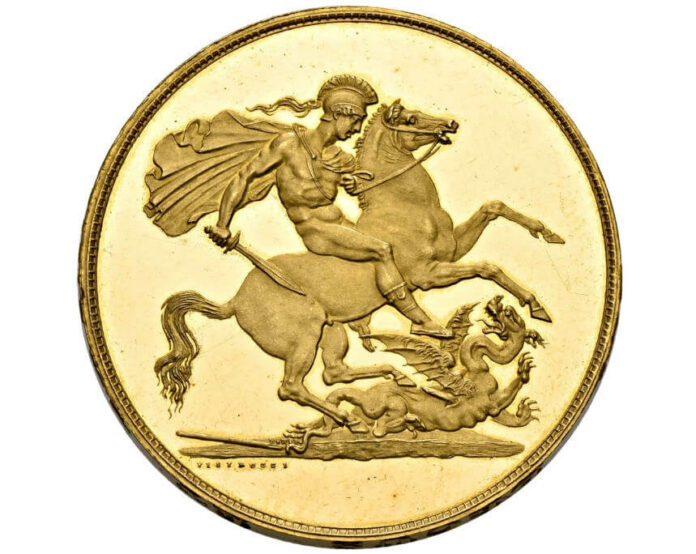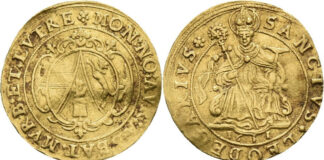The date is 29 January 1820. It’s cold. On his deathbed in Windsor Castle lies a man whom the world has long since written off: George III, 81 years old, blind, deaf, demented and now also sick with pneumonia. As the monarch fights for his life, the minting press at the Tower Hill mint is working at full tilt. The master of the mint, William Wellesley Pole, is keen to complete the patterns for the new 5-pound coins while the King is still alive. He has ordered a night shift especially for this purpose.
Around 30 years later, Edward Hawkins, curator of the coin collection at the British Museum, wrote that “the dies were scarcely finished when the decease of the king was hourly expected; and though the workmen were employed in striking them throughout the night, we believe that all the five- and two-sovereign pieces were not actually completed during the reign of King George III.” William John Hocking, who started working at the Royal Mint over 60 years later, even claimed that “the dies were not completed at the demise of George III [and] specimens were subsequently struck.”
What a unique coin this must have been if such eminent experts were still wondering, generations later, whether it was minted hours before or after the King’s death!
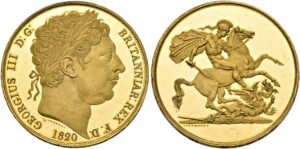
A Pattern of the New 5-Pound Coin
This pattern is now regarded as the most spectacular British gold coin of the modern era. It represents the very first attempt to mint a multiple sovereign. SINCONA is proud to present what is probably the best specimen of this minuscule issue of 25 pieces in Part 4 of its British Collection in Auction 82 on 15 May 2023. The coin was purchased by Schweizerische Kreditanstalt in 1970 and has remained in the collection for over half a century since then. The experts at NGC found this coin to be the highest-graded piece they had ever seen.
The obverse of the pattern features a Roman-style portrait of George III with a laurel wreath, designed by Benedetto Pistrucci, who signed his work below the neck truncation. The inscription reads GEORGIUS III D: G: – BRITANNIAR: REX F: D: / 1820, which translates as George III, by the Grace of God, King of the Britains – meaning the United Kingdom of Great Britain and Ireland –, Defender of the Faith.
The reverse features the iconic image of St. George slaying the dragon with his sword. The signature PISTRUCCI is also featured in the exergue. The edge inscription reads DECUS ET TUTAMEN. ANNO REGNI LX, meaning “honour and protection, in the 60th year of the reign”.
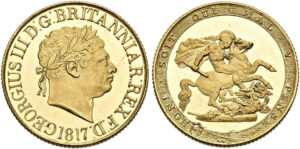
The design is an exact replica of the images created by Italian sculptor Benedetto Pistrucci for the sovereign, first issued in 1817. This icon of British coinage is a symbol of new beginnings: when the Tower mint and its completely outdated equipment were no longer able to produce enough small change for Great Britain, the British government decided to open a new mint on Tower Hill. It was modelled after the private Soho Mint and equipped with state-of-the-art machinery. In the summer of 1811, production commenced at the new mint. In September 1814, the energetic William Wellesley Pole was appointed to run the mint and modernise the British coinage system. He was assisted in this task by an extremely talented die-cutter, the Italian Benedetto Pistrucci.
There are many stories about how the Italian gem-cutter caught the attention of the British mint master. Most of them involve Sir Joseph Banks, a famous naturalist, who is said to have commissioned the Italian artist to sculpt his own portrait. Utterly thrilled by Pistrucci’s work, Banks then recommended him to Pole, who was already working on a proposal for new gold coins of 10, 20 and 40 shillings or 5 pounds. Pole therefore modified the proposal, requesting that the new design not be entrusted to the permanent engravers at the Tower Hill mint, but rather to “Mr. Pistrucci, an artist of the greatest celebrity and whose work places him above all competition as a gem engraver.” On 26 June 1816, this request was approved, along with a fee of 100 guineas (= 105 pounds), even before Pole’s proposal for the denomination of the new gold coins was accepted on 3 August 1816.
This meant that the first sovereigns with the new designs could be issued as early as July 1817. The coins issued in the first three years still depict the Ribbon of the Order of the Garter on the reverse; this order was dedicated to St. George, who also features on the coin. The inscription reads HONI SOIT QUI MAL Y PENSE (= shame on anyone who thinks ill of it).
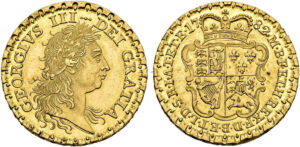
The new sovereign was extremely forgery-proof for its time, and secure against manipulation. Its design was informed by the results of many decades of research. As early as 1782, the mint was experimenting with new security features at the initiative of inventor Charles Stanhope. One pattern, dated 1782, implemented ideas that were published by Stanhope in his 1775 paper “Considerations on the means of preventing fraudulent practices on the gold coin”.
According to him, moving decorative elements to the edge and including an edge inscription would make it impossible to file off any gold from the coin’s edge. It had been extremely difficult to produce such coins with the equipment available at the old Tower mint. However, the new coin presses created by Boulton featured a collar, which made it easier than ever to add an edge inscription. As a result, both of these security features could be implemented when it came to mass-minting the new sovereigns – by 1817, the mint had produced 3,235,239 sovereigns.
Pole must have been very pleased with Pistrucci’s work, because when the chief engraver at the Tower Hill mint passed away on 22 September 1817, he attempted to secure the post for the Italian engraver. This attempt failed; there was a law that prohibited foreigners from being appointed to the role. In response, Pole – much to the annoyance of William Wyon, assistant chief engraver and cousin of the deceased – left the post vacant and made an informal agreement with Pistrucci. He received an annual salary of 500 pounds, lived in the chief engraver’s house on the Tower Hill mint premises and unofficially held the role of chief engraver. In 1819, this also involved adapting the sovereign coin design for a 5- and 2-pound coin.
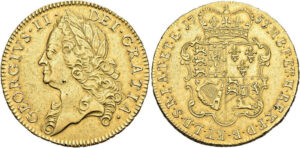
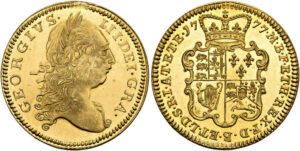
A Race Against Time
1754 was the last year in which 5-guinea pieces were regularly issued. After that, patterns of 5- and 2-guinea coins were produced, but none of the pieces were officially released. Now, the royal edict permitted Pole to produce these pieces, but it was perhaps unclear whether or not this permission would be revoked after George III’s death. That’s why Pole pulled out all the stops to use the elaborate dies at the last minute.
Whereas 60 of the double sovereigns were minted, there are just 25 specimens of the 5-sovereign pieces in existence – and we know who bought each and every one of them. Six went straight into museums: the Royal Mint, the Bank of England, the British Museum, Glasgow University, Dublin College and the Bodleian Library in Oxford each acquired one of the specimens. Eight pieces were given to the employees at the mint. The remaining pieces were offered to well-known coin collectors.
The assistant chief engraver William Wyon is said to have been the first to resell his piece. The man who bought it, coin dealer Abraham Edmonds, then sold it to William Bennett Rich of Bermondsey for 25 pounds, five times its face value. That would have been enough to feed three or four London orphans for a whole year. This enormous sum gives us an idea of how remarkable this coin was already considered to be by its contemporaries.
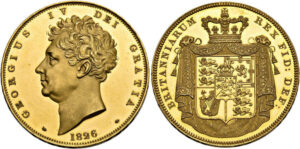
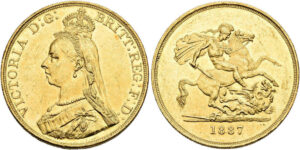
5-Pound Coins – What Happened Next?
5-pound coins would actually remain a rarity for a long time to come. Under George IV, they were only produced once in 1826, in a tiny mintage of around 400 specimens. The next 5-pound piece wouldn’t be produced for a good decade. “Una and the Lion”, issued in 1839, is now one of the most sought-after coins on the collector’s market. And after that, it was almost another half a century before the first extensive issue of 5-pound coins was produced to commemorate Queen Victoria’s Golden Jubilee in 1887.
You can find all coins in Part 4 of SINCONA’s British Collection on the SINCONA website.




